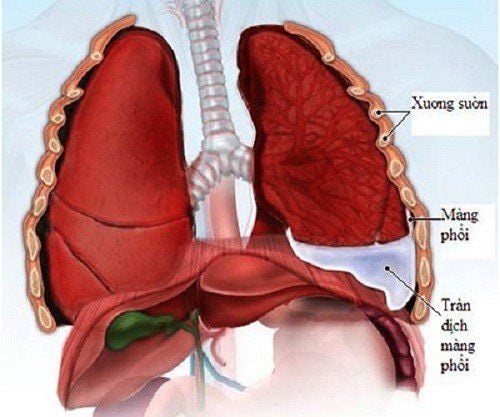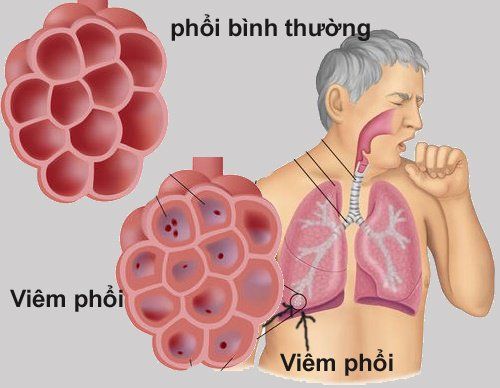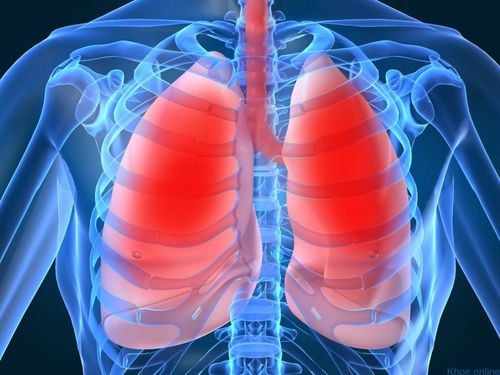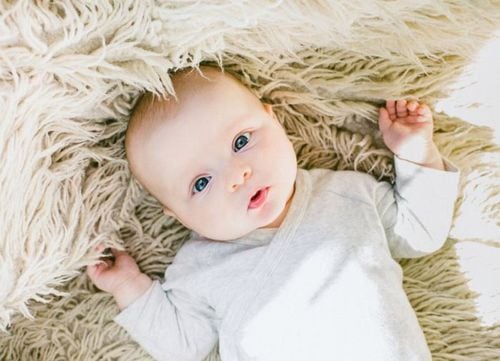This is an automatically translated article.
The article was professionally consulted by Dr. Le Thu Phuong - Department of Pediatrics - Neonatology - Vinmec Hai Phong International General Hospital.Pneumonia is a common disease and one of the main causes of death in children. The majority of pneumonia cases are caused by a virus, and management relies heavily on proper care and resolution of symptoms. With good care, the child will recover quickly.
1. Overview of pneumonia in children
Pneumonia is a disease that refers to an infection of the lungs. The air sacs in the lungs are filled with mucus, which prevents the body from absorbing enough oxygen.Causes of pneumonia can be caused by:
Viruses, bacteria, fungi and parasites. In most cases, this disease is caused by viruses such as adeno virus, rhino virus, influenza virus, etc. Several factors can increase the risk of pneumonia in children such as living in high-pollution areas, having a close relative who smokes or being regularly exposed to second-hand smoke. If the treatment of pneumonia in children is delayed, it can cause many dangerous complications that affect the child's development later on, such as: meningitis, blood infection, empyema, pericardial effusion, heart failure, antibiotic resistance, underdeveloped rickets. Therefore, parents need to detect early symptoms of the disease to take care of their children properly.
Usually, pneumonia occurs after an upper respiratory tract infection. Symptoms of the disease begin to appear 2 or 3 days after you have a cold or sore throat. Then they attack the lungs. Mucus, white blood cells... gather in the alveoli of the lungs, making it difficult for the body to absorb oxygen. This inadvertently causes the baby to breathe faster so that the lungs can supply the necessary amount of oxygen to the body.
Children with pneumonia often progress quite quickly. Depending on the age of the child and the cause of the disease, the symptoms of pneumonia will vary. General symptoms of the disease may include:
The child is wheezing or sounds like a hissing sound. This is probably the most common sign. Sudden high fever and rapid breathing, unusually rapid breathing, trying hard to breathe. Sore throat, headache and rash. If a child has pneumonia caused by pertussis, he will have long-lasting coughs, pale face due to lack of oxygen or when breathing sounds like a hissing sound. Nasal congestion, chills, vomiting Chest tightness, abdominal pain (because of cough and difficulty breathing) Fatigue, inactivity Loss of appetite (in older children) or unwillingness to feed (in infants), can lead to dehydration of lips, blue or gray nail tips. If the inflammation occurs in the lower part of the lungs (located near the abdomen), the child may have a fever, abdominal pain, or vomiting, but no signs of respiratory illness.
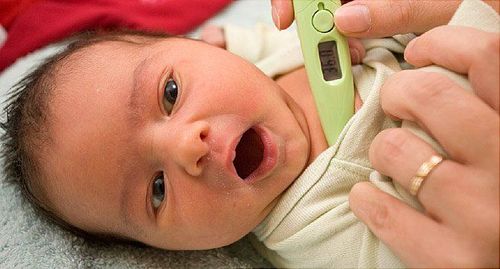
2. Proper treatment and care of children with pneumonia
2.1. Proper treatment of pneumonia in children The treatment of pneumonia in children depends on many factors, including the physical condition and the suspected cause of the pneumonia (viral, bacterial, fungal, or parasitic).Depending on the cause of the disease, the doctor will prescribe the appropriate medicine to treat pneumonia in children. If the illness is caused by a virus, the baby does not need to take antibiotics. If the illness is caused by bacteria, your baby will need to be treated with antibiotics.
Most children with pneumonia can be treated at home.
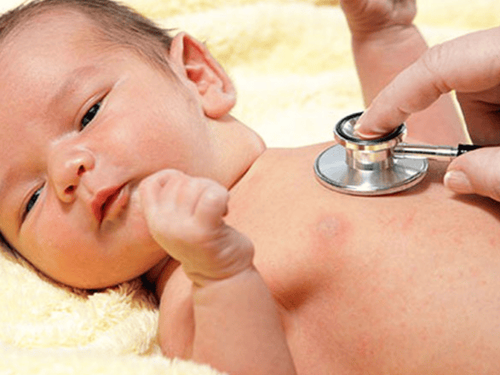
Reduce fever for children:
Actively apply warmth, the water temperature is determined by dipping an adult's elbow into it. basin of water, if it feels warm is fine. If the child's fever is above or equal to 38.5°C, give the child fever-reducing medicine as prescribed by the doctor. Slapping the back and helping children to effectively excrete sputum is one of the ways to treat pneumonia in children. The method of patting children on the back when they have a cough with phlegm will help circulate the blood of the lungs, help the phlegm in the bronchi loosen and be discharged easily. Back patting is best done before meals or as early as 1 hour after eating to avoid inducing vomiting. Be careful not to hit the stomach, sternum or spine. Instruct children to cough (Coughing is a beneficial response of the body, helping to open the airways and push secretions out of the lungs):
With older children, ask them to cough after being patted in each area. When the child has not stopped coughing, do not continue to pat. Have the child sit up, head slightly forward, inhale, open the mouth and contract the abdominal muscles to cough deeply, not coughing in the throat. Then inhale again. Continue coughing until sputum is expelled. For young children, it is possible to use a vacuum cleaner to suck sputum out of the oropharynx when the child cannot cough up on its own. Hygiene and diet for children:
For hygiene of the nose and mouth, parents use a soft tissue to wipe off their nose and drool and then discard the tissue immediately after use. If using a bucket towel, pay attention to keeping the towel clean. Cleaning children's houses, toys and utensils. Caregivers should wash their hands thoroughly when caring for and preparing food for children. Give your child nutritious, soft, easy-to-digest and easy-to-swallow foods. Feed children according to their needs, divide many meals a day and the quantity of each meal is less than usual, do not force children to eat all the food that parents have prepared. When children cough, can use steamed kumquats with honey (do not use honey in children under 1 year old because of the risk of allergies), steamed roses, ginger, lemon for children to drink to reduce. When a child has a cough, runny nose accompanied by one of the following signs, immediately take the child to the hospital:
There is a chest cavity (the part between the abdomen and the chest that is concave when the child breathes in). Exhausted breathing, bulging nose, pale purple. Wheezing or wheezing when lying still. Inability to drink, convulsions or lethargy difficult to awaken. High fever, unresponsive to antipyretics.
3. How to prevent pneumonia in children
Some types of pneumonia can be prevented with vaccines. Children are routinely vaccinated against Haemophilus influenzae pneumonia and pertussis starting at 2 months of age (5 in 1 vaccine). Influenza vaccination is recommended for all healthy subjects between the ages of 6 months and is repeated once a year, regardless of age. Pneumococcal vaccine is also considered and should be started at 6 weeks of age. Children with chronic conditions such as heart or lung disorders or asthma should be fully vaccinated.Clean, avoid spreading. Do not smoke, cook in the room with small children. Isolate children from sick people to avoid spreading the epidemic.
Children's place must have enough light, cool, good air circulation. If using an air conditioner, it should be adjusted so that the temperature difference between indoor and outdoor is from 5 to 7°C so that the child can adapt.
Early detection of early manifestations of respiratory infections in general such as cough, fever, runny nose, difficulty breathing... and other disorders such as diarrhea, poor appetite, slow weight gain... to timely care and treatment.
During pregnancy, the mother must have a full antenatal check-up, ensure the fetus develops well, have a diet full of nutrients such as protid, lipid, vitamins, mineral salts... after birth to 2 years old so that the child's body develops comprehensively and is better able to resist diseases.
As a key area of Vinmec Health system, Pediatrics Department always brings satisfaction to customers and is highly appreciated by industry experts with:
Gathering a team of top doctors and nurses in Pediatrics : consists of leading experts with high professional qualifications (professors, associate professors, doctorates, masters), experienced, worked at major hospitals such as Bach Mai, 108.. Doctors All doctors are well-trained, professional, conscientious, knowledgeable about young psychology. In addition to domestic pediatric specialists, the Department of Pediatrics also has the participation of foreign experts (Japan, Singapore, Australia, USA) who are always pioneers in applying the latest and most effective treatment regimens. . Comprehensive services: In the field of Pediatrics, Vinmec provides a series of continuous medical examination and treatment services from Newborn to Pediatric and Vaccine,... according to international standards to help parents take care of their baby's health from birth to childhood. from birth to adulthood Specialized techniques: Vinmec has successfully deployed many specialized techniques to make the treatment of difficult diseases in Pediatrics more effective: neurosurgery - skull surgery, stem cell transplantation. blood in cancer treatment. Professional care: In addition to understanding children's psychology, Vinmec also pays special attention to the children's play space, helping them to have fun and get used to the hospital's environment, cooperate in treatment, improve the efficiency of medical treatment.
Please dial HOTLINE for more information or register for an appointment HERE. Download MyVinmec app to make appointments faster and to manage your bookings easily.





